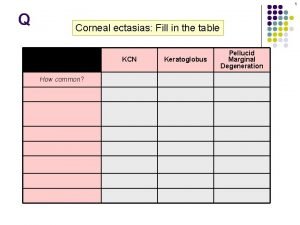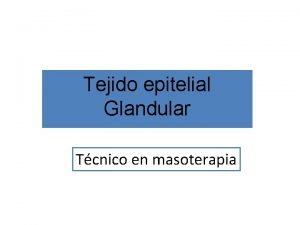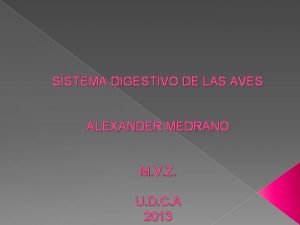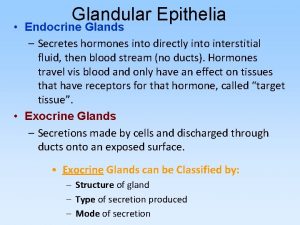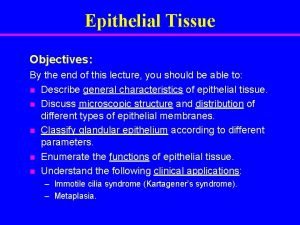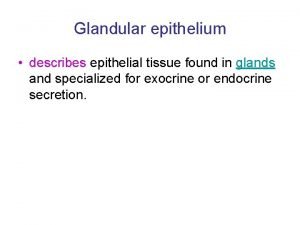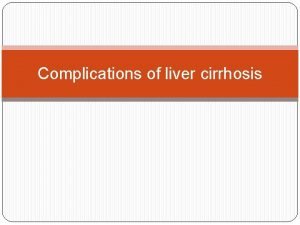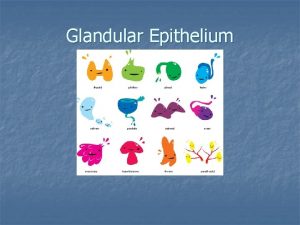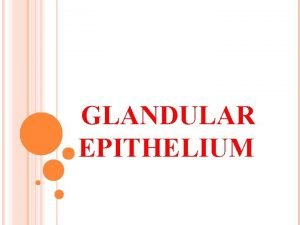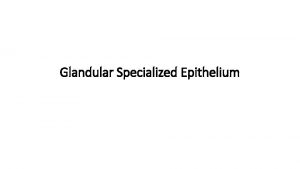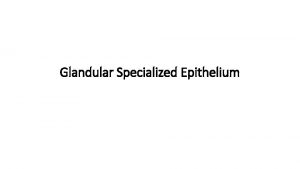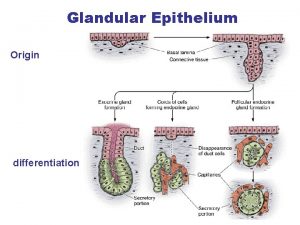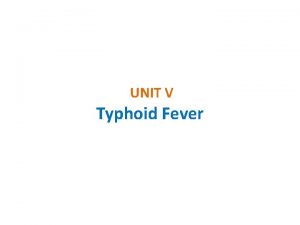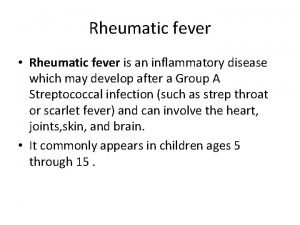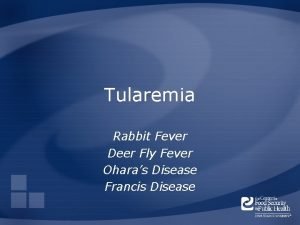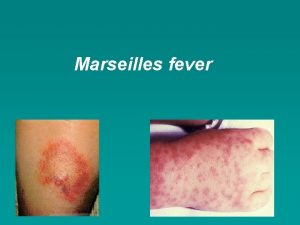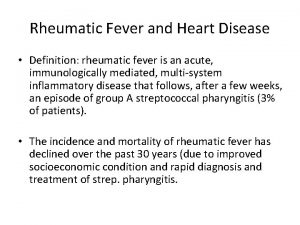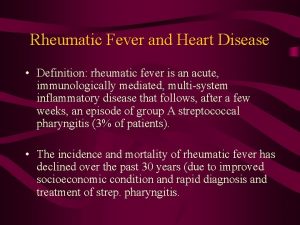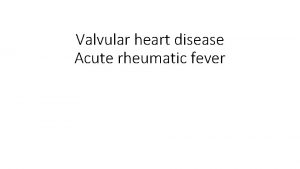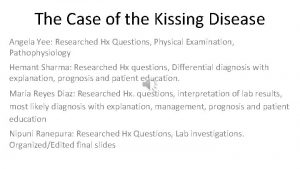Glandular Fever The Kissing Disease Why Glandular Fever


































- Slides: 34

Glandular Fever The Kissing Disease !!!!! Why ? ? ?

Glandular Fever Caused by infection with the Epstein-Barr virus very low infectivity rate because the virus is “environmentally fragile” in that it’s survival outside the human body is very poor

Glandular Fever Spreads by: • Coughing • Sneezing • Kissing

Glandular Fever Clinically: Age of presentation: 15 - 40 (usually) Symptoms: None (usually) (The infection is usually subclinical) Occassionally….

Glandular Fever Clinically: In Symptomatic cases: Bilateral cervical lymphadenopathy in 75% of symptomatic cases Generalized lymphadenopathy in 50% of symptomatic cases Sore throat >50% of symptomatic cases. Fever of varying severity Visual Problems - photophobia – conjuctivitis - peri-orbital oedema

Glandular Fever Clinically: More rarely: Spleno-hepatomegaly • About 15% of symptomatic cases • About 5% of symptomatic cases are jaundiced Haemato-pathology • About 1% of symptomatic cases there is: • Severe anaemia (auto-immune) • Purpura due to thrombocytopenia

Glandular Fever Laboratory Findings: Nothing abnormal…. . If the patient presents very early in the course of the disease, there will be no abnormalities evident.

Glandular Fever Laboratory Findings: An atypical lymphocytosis • Lymphocyte count of 10 - 20 x 10 9 cells/litre is usual in symptomatic cases. • These cells appear reactive • Usually evident after a week or so.

Glandular Fever The Paul – Bunnell Test: (historically) In most symptomatic cases of glandular fever there is circulating heterophile antibody. These are absorbed by ox red cells but not by guinea pig kidney cells and agglutinate formalized horse red cells Who thinks this up ? ? ?

The GF test Two drops of plasma

The GF test Two drops of plasma Drop some minced guinea pig in this one

The GF test Two drops of plasma Drop some minced guinea pig in this one And some minced ox in this one

The GF test Two drops of plasma Drop some minced guinea pig in this one And some minced ox in this one

The GF test Two drops of plasma Drop some minced guinea pig in this one And some minced ox in this one

The GF test Two drops of plasma Drop some minced guinea pig in this one And some minced ox in this one Mix it in

The GF test Two drops of plasma Mix it in

The GF test Two drops of plasma Leave for thirty seconds

The GF test Two drops of plasma Leave for thirty seconds The minced ox absorbs the heterophile antibody

The GF test Two drops of plasma The minced guinea pig does not Leave for thirty seconds The minced ox absorbs the heterophile antibody

The GF test Two drops of plasma Add some formalized horse cells

The GF test Two drops of plasma Add some formalized horse cells

The GF test Two drops of plasma Add some formalized horse cells

The GF test Two drops of plasma And mix for one minute

The GF test Two drops of plasma

The GF test Two drops of plasma The heterophile antibody has not been absorbed by the minced guinea pig

The GF test Two drops of plasma And so agglutinates the formalised horse cells

The GF test Two drops of plasma And so agglutinates the formalised horse cells The heterophile antibody has been absorbed by the minced ox cells

The GF test Two drops of plasma And so agglutinates the formalised horse cells And so is no longer present to agglutinate the formalised horse cells

The GF test - Nowadays One drop of plasma – “one stage” One drop of plasma Add latex coated with purified Paul. Bunnell antigen and mix Presence of IM heterophile antibody causes agglutination

The GF test - Nowadays One drop of plasma – one stage

Is this test a good test for glandular fever ? It doesn’t test for glandular fever It tests for the body’s reaction to it Therefore it has limitations

Glandular Fever Clinical Chemistry Findings: Liver function deranged in extreme cases

Glandular Fever Treatment: No treatment The majority of cases are sub clinical Symptomatic cases have symptomatic treatment The condition is self limiting The very few severe cases may be treated with corticosteroids.

Glandular Fever Recovery: • Takes 4 - 6 weeks • convalescence is slow • severe malaise & lethargy • Wait for negative GF test…. ?
 Why why why why
Why why why why Edith wharton roman fever summary
Edith wharton roman fever summary Normal vs high palate baby
Normal vs high palate baby Larry and bobby kissing
Larry and bobby kissing Kissing circle theorem
Kissing circle theorem Kissing doves topography
Kissing doves topography Kissing balloon manöver
Kissing balloon manöver Why does james gatz change his name
Why does james gatz change his name The kissing hand vocabulary words
The kissing hand vocabulary words Kissing fleur adcock
Kissing fleur adcock Kissing nodules
Kissing nodules Bharathi viswanathan
Bharathi viswanathan Don't ask why why why
Don't ask why why why Insufficient glandular tissue pictures
Insufficient glandular tissue pictures Sistema exocrino dibujo
Sistema exocrino dibujo Aparatul genital masculin
Aparatul genital masculin Funcion de la molleja en las aves
Funcion de la molleja en las aves Glandular epithelial tissue
Glandular epithelial tissue Glandular meats
Glandular meats Glandular epithelia
Glandular epithelia Epithelial tissue
Epithelial tissue Epithelia
Epithelia Ceystolith hair
Ceystolith hair Pancreas organ function
Pancreas organ function Acinar compuesta
Acinar compuesta Tejido osea esponjoso
Tejido osea esponjoso Zonula
Zonula Salivary gland histology
Salivary gland histology Que es el sistema glandular
Que es el sistema glandular Why does liver disease cause splenomegaly
Why does liver disease cause splenomegaly Hát kết hợp bộ gõ cơ thể
Hát kết hợp bộ gõ cơ thể Slidetodoc
Slidetodoc Bổ thể
Bổ thể Tỉ lệ cơ thể trẻ em
Tỉ lệ cơ thể trẻ em Voi kéo gỗ như thế nào
Voi kéo gỗ như thế nào





